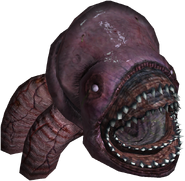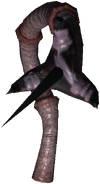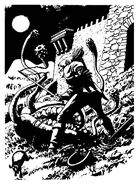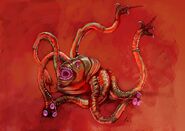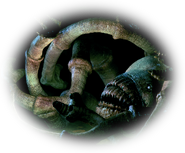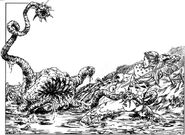Zeugls inhabit sewers predominantly, feeding on sewage, and grows at an alarming rate. The beast is always hungry, so it reaches out with its tentacles for living creatures and tries to shove them into its huge maw filled with multiple rows of teeth. The zeugl is paralyzingly hideous, foul-smelling, and surprisingly strong for something resembling a rotten potato, so it usually manages to devour its opponent.[1][2]
Geralt was hired to rid the sewers of a zeugl during his and Yennefer's stay in Aedd Gynvael.[1] There is also a breed of zeugl mutated by Rissberg mages called parazeugl, which in turn is not at all dangerous and cleans the sewers.[3]
Quick Answers

What is the primary habitat of a Zeugl?

What does a Zeugl predominantly feed on?

What are the physical characteristics of a Zeugl?

Who was hired to rid the sewers of a Zeugl?

How does a Zeugl capture its prey?

The Witcher
In the game, the zeugl is one of the boss monsters. Geralt must face this ugly beast in the Vizima sewers during the Epilogue, and this time, the tentacles seem to have a mind of their own! Luckily our hero is not forced to face the beast alone.
Journal Bestiary entry
"The zeugl is the best example of a monster that has grown accustomed to human settlements. The beast feeds on the waste and filth produced by the city, so it need not hunt or fight to survive. It simply grows and gradually becomes a danger to people. This shows how detrimental continued degradation of the natural environment can be in the long run. Therefore, I implore the reader: respect nature."
Location
- Vizima sewers in the Epilogue
Source
Notes
- According to Geralt just before they enter the sewers, zeugls are hermaphrodites that do not need a mate to procreate. In a hilarious conversation with Siegfried, he intimates that "zeugls do not need a Mrs. Zeugl to make little zeugls. They do it with themselves." To which Siegfried responds "That's sick! ... unnatural even for beasts!" This exchange is a paraphrasing of an conversation between Herbolth and Geralt in Sword of Destiny.
- Geralt can still extract zeugl venom after the fight in the sewers even if he has no bestiary entry for Zeugl (in case you forgot to buy one of the two source books earlier.)
Monsterbook
Developer CD PROJEKT RED's characterization of the Zeugl taken from the monsterbook, which was included with the Polish, Hungarian and Czech Collector's Edition of The Witcher computer game:
This huge monster inhabiting the sewers beneath Vizima looks like a medieval environmentalist's nightmare. It feeds on the garbage and carrion that slowly drift with the flow. The zeugl can grow to be enormous in size, and being a hermaphrodite, it reproduces easily. A fully grown specimen is a serious threat to humans and very difficult to kill.
Only the top part of its body and tentacles ever surface above the sewage - and these are the most important elements of its design. The black on red sketches present the creature in all its glory. Sapkowski described it as a "hideous bulge" - and such is our zeugl. The concept artist provided it with a fish-like head and a few rows of sharp teeth suitable for grinding whatever reaches the monster's jaws. If the victim is not quite dead, the zeugl's tentacles feature spikes that allow the creature to pull its prey into its mouth.
The sketch above focuses on the zeugl's cephalothorax - the monster's head resembles that of a fish, while the folds on its back bear a likeness to mushroom caps.
Notes
- In The Witcher 3: Wild Hunt, when Keira slightly changes her favorite fairy tale, Cinderella, Geralt explains how it was based on a true story where Princess Cendrilla was eaten whole by a zeugl that hid in the palace pond, leaving behind one shoe.
- In The Witcher 3: Wild Hunt, Vesemir recalls the time when Geralt fought a zeugl in Tretogor.
- In The Witcher 3: Wild Hunt, during the ball in the Vegelbuds' estate, if the player chooses to play Gwent with the nobles, his last opponent is said to have a zeugl bone amulet that brings him good luck on the table.
